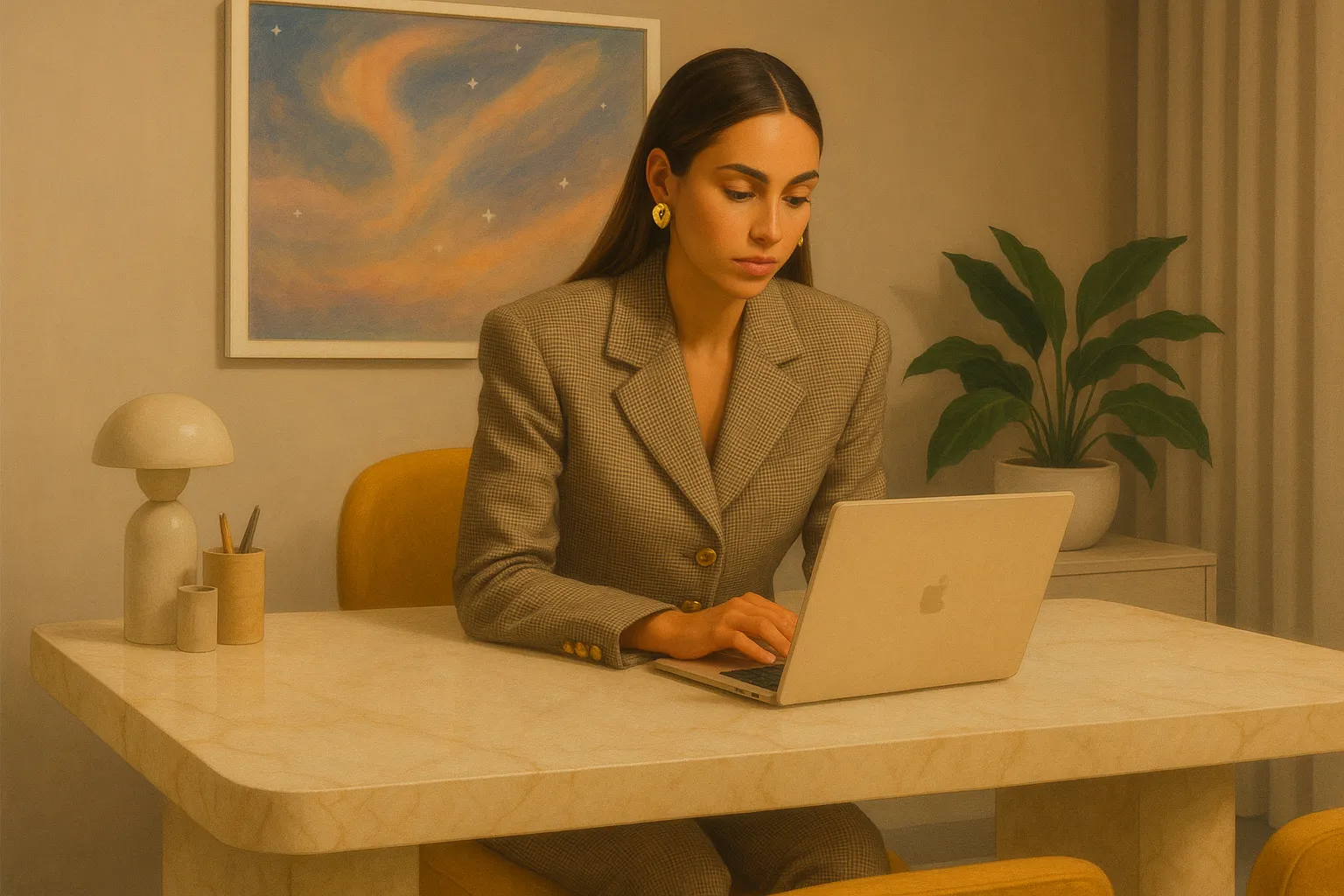Startup School
The Home Office Glow-Up: Design Hacks for Focus & Flow
Six expert-backed ways to boost productivity—no renovation required.

- Published
- Category
- Startup School
Related Articles
The days of the predictable 9-to-5 are long gone. Whether leading a team, launching your next big idea, deep in creative flow, or juggling all three, your workspace should support you, not slow you down. Yet many of us are still working in setups that no longer reflect our schedule or who we are today.
So we asked interior designers, entrepreneurs, and founders to share their most transformative, actionable tips to help you rethink and revamp your space. The good news? You don’t need a full renovation to spark big shifts in energy and focus. Sometimes, it’s as simple as repositioning your desk or lighting a candle.
Here’s how to give your home office the glow-up it deserves.
1. Keep It Clean
Before you add anything new to your space, start by subtracting. A cluttered desk, tangled cords, or piles of paperwork can quietly chip away at your focus, whether you realize it or not. When your space feels chaotic, it’s harder for your brain to settle and prioritize.
Creative director Lindsay Jane Kelly, founder of JaneMade, a full-service creative studio, knows this firsthand. “I find clutter extremely distracting,” she says. “Any projects that don't require my immediate attention go into a cabinet, along with all our paper and packaging samples. This helps me keep my focus on what matters now.”
Interior designer Nadia Watts agrees. “One of the biggest design mistakes is overcrowding the space. When every surface is filled, your mind can feel overloaded.”
Even a quick reset at the start or end of your day—clearing off your desk, putting things back in place—can be the difference between flying through your to-do list and feeling stuck.
2. Lighting Matters More Than You Think
And we’re not just talking about a ring light for Zoom calls. Lighting isn’t just a design choice; it’s a functional powerhouse. “Lighting is often treated as an afterthought,” Watts says, “but the right lights can completely transform your ability to focus and feel energized.”
If you can, prioritize sunshine. “Natural light is ideal; I love having my desk in front of a large window overlooking my garden,” Watts adds. But artificial light can work just as well—especially when it’s layered with intention. Watts recommends combining ambient, task, and accent lighting to reduce eye strain and support different kinds of focus throughout the day.
Cooler, daylight-spectrum bulbs are great for boosting alertness and mimicking morning sun during deep work blocks. Warmer tones, on the other hand, create a more relaxed mood—ideal for late afternoon wind-downs or creative stretches. Even just having a few adjustable light sources gives you more control over the energy of your space as the day shifts.
3. Let Color and Texture Set the Tone
Don’t underestimate the power of color in your workspace. It’s not just decorative—it’s emotional. Different hues evoke different energies, and your choices can either support your focus and well-being or quietly work against them.
Soft, earthy neutrals and greens can create calm and clarity,” says Watts.
“While pops of gem tones can energize and inspire.” Think of warm taupes, sage greens, or creamy whites as grounding tones that help your nervous system settle. In contrast, shades like sapphire blue, emerald green, or deep amethyst can spark creativity and motivation when used intentionally as accents. Texture adds another layer of intention. “Woven materials, soft textiles, natural woods—these make the space feel lived-in and supportive,” says Watts. Whether it’s a nubby throw, a woodgrain desk, or a linen curtain, tactile touches help create a space your body can relax into, so your mind can focus.
4. Create Micro-Zones for Different Work Modes
Your brain doesn’t operate the same way when you’re in a Zoom meeting as it does when you’re reading, brainstorming, or powering through your inbox. That’s why entrepreneur and founder advisor Dayna DeStefano suggests breaking your workspace into functional “zones” to boost focus, flow, and flexibility, no matter how big (or small) your space is.
You don’t need a huge office to do the same—just a little intention.
Use a standing desk (or even a countertop) for active tasks like calls or email sprints.
Set up a comfortable chair or small couch for reading, light admin work, or casual brainstorming sessions.
Designate a creative corner with a whiteboard, calendar, or notepad—somewhere you can step away from your screen to sketch ideas or plan big-picture goals.
And if you're working with limited square footage, you can still make your setup feel purposeful. “Even if it’s just a corner,” says Watts, “use a small rug, a folding screen, or a bold wall color to define the area as yours.” Thoughtful touches (a lamp you love, a piece of art, or a small vase of flowers) can help signal that it’s time to focus.
5. Personalize Your Space
A productive home office should be functional, but it should also feel personal, inspiring, and uniquely yours.
“I start by defining the primary work area, where the deep focus happens, and balance it with softer, personal touches nearby,” says Watts. “A comfortable chair for reading, meaningful art for inspiration, or a stylish bookshelf with objects that reflect who you are. When your space tells your story, it becomes more than just a work area; it becomes a sanctuary for creation and clarity.”
These personal elements not only look good, they also serve a mental purpose. According to Watts, visual cues can be powerful tools for shifting your brain into work mode. “I love working with clients to establish rituals through design,” she says. “It might be a tray that holds your morning coffee and favorite pen, or a specific piece of art that keeps your vision front and center.”
6. Design Around Rituals and Energy Flow
It’s less about how it looks and more about how it functions in your daily rhythm. “A beautifully designed space serves you—visually, emotionally, and practically,” says Watts. That means designing not just for productivity, but for presence.
For DeStefano, that meant reworking her layout with a Feng Shui expert to reflect the more creative, less screen-heavy season she found herself in. “A few months ago, I realized my office no longer embodied the work I was doing,” she says. “So I rearranged it so my desk faced a window, brought in plants, and added objects that made me feel more alive and inspired.”
Your workspace doesn’t need to be photographed for Architectural Digest—it just needs to work for you. Whether clearing the clutter, adjusting your lighting, or adding small rituals that bring you back to focus, even the simplest changes can create a ripple effect in how you think, feel, and show up.







